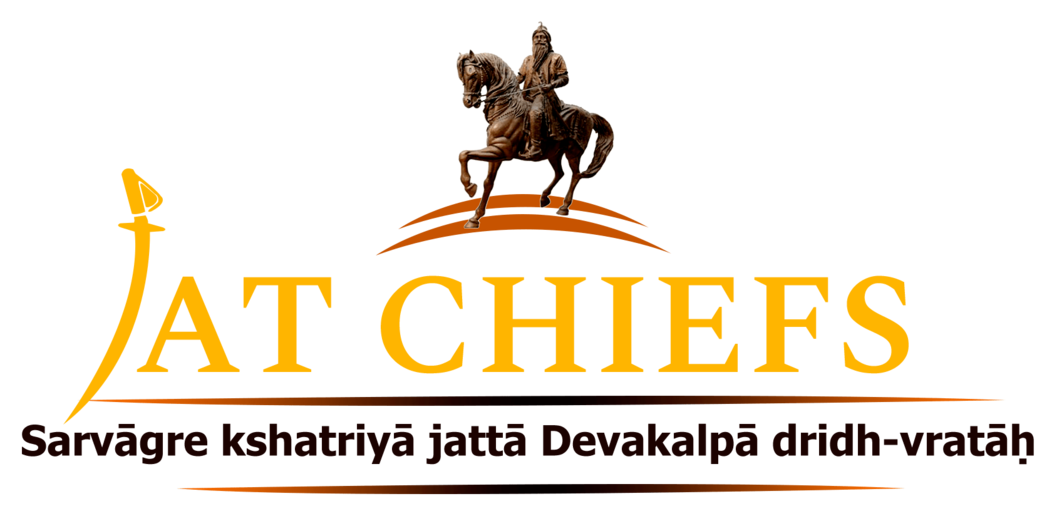History

Flag of Ballabgarh
Chaudhary Gopal Singh, a Tewatia Jat, the founder of the house of Ballabgarh, was a residence of Alawalpur. In 1705,He established himself at Sihi (5 kilometres (3.1 mi) from Ballabhgarh) after displacing the local Mughal fauzdar from there. Gopal Singh of Sihi started establishing his power in Delhi, Faridabad and Palwal areas. He attacked and killed Amzad Khan,the Chaudhary of Faridabad Pargana in 1705. He became more powerful and richer and started to waylay the Mughal caravan on Delhi-Agra royal route during the reign of Aurangzeb (d. 1707). In 1710, during the reign of Aurangzeb’s son Bahadur Shah I, the Mughal officer Murtaza Khan of Faridabad signed a treaty with Gopal Singh confirming Gopal as Chaudhary of Faridabad pargana. He wanted to expand his army and collect huge wealth but soon died in 1711. Gopal’s successor was his son Chaudhary Charan Das , who was also ambitious. When Charan Das saw weakening of the Mughal rule, he stopped paying malgujari (octroi) to Mughals. As a result, Mughals arrested and imprisoned Charan Das at Faridabad fort for a short time in 1714,during the reign of Farrukhsiyar (r. 1713-1719). His son Balram Singh freed him by pretending to pay the ransom.
Supported by his family connection with Badan Singh, the Jat Raja of Bharatpur , He extended his power by seizing the neighbouring villages and ousting their lawful owners and the local magistrates. In 1720, He killed Murtaza Khan, the local Mughal Governor Officer at Faridabad who had once imprisoned his father . He subsequently increased his power and ousted Santosh Rai from Palwal and took possession of the town. He also conquered Mehrauli, Dhankaur,Hathin and other parganas. in 1739, Mughal Emperor bestowed on him titles of “Rao” and “Naib Bakshi”. The next year He built the Balramgarh fort and founded the city of Ballabhgarh is named after him.
After Muhammad Shah’s death in 1748, Balram Singh expelled the imperial outpost at Shamspur. On 11 January 1750, Rao Balram Singh of Ballabhgarh, Maharana Suraj Mal of Bharatpur and Rana Bhim Singh of Gohad waged a battle against forces of Mir Salawat Khan , which the Jats won and Mughals had to conceded a lot concessions.
On 30 June 1750, Safdar Jung, marched against Balram but Balram managed to evade him using stratagem with the help of Marathas. Emperor Ahmad Shah Bahadur replaced Safdar Jung with Gaziuddin Khan (“Intizam-Ud-Daullahas” or “lmad-ul Mulk”, the imperial Mir Bakhshi) as new wizir. Safdar Jung, supported by Balram Jat and Surajmal Jat, revolted against the Mughal king. Balram Singh rose to high prominence when he plundered the emperor’s own Jagir of Sikandarbad. The Emperor send Gaziudin Khan against Balram Singh. Murtija Khan’s son Aqaibet Mahmud Khan was the chief diwan of Gaziuddin Khan, he and Balram agreed to meet to negotiate the terms of truce. Balram arrived with his son, diwan and 250 men, angry words flew, Balram put his hand on his sword, Aquibat’s guard suddenly fell upon Balram and killed him, his son, diwan and 9 other escorts. Maharaja Suraj Mal retaliated by capturing Palwal from Mughals on 27 September 1754. He also caught the qazi there and slayed the qanungo Santokh Rai for scheming Balram’s murder. In November 1755, Jats under Suraj Mal recaptured Ballabgarh from Mughals. Suraj Mal appointed sons of Rao Balram, Bishan Singh as Nazim and Kishan Singh as kiledar. In 1774 however he dismissed them from his service and they died about the same time. Next year Ajit Singh, son of Bishan Singh, and Hira Singh, son of Rao Kishan Singh, presented themselves before the Emperor at Delhi and agreed to deliver possession of the Ballabgarh parganah to the royal authority: one Najaf Khan of the imperial establishment was deputed to take it. Ajit Singh was appointed Kiladar and Nizam of Ballabgarh while Hira Singh was taken away by the Nawab Najaf Khan to Agra. The next year he came back and Ajit Singh was formally entitled Raja, and Hira Singh was called Raja and also Salar Jang. The revenue of Ballabgarh was estimated at Rs. 1,20,000 and it was made an istamrdr tenure of 60,000 rupees. Meanwhile the administration of the country had come into the hands of Madhoji Scindia who remitted the amount taken as istamrari. In 1793 Ajit Singh was murdered by his brother Zalim, but was succeeded by his son Bahadur Singh. In 1803 on the approach of General Lake, Bahadur Singh sent his son Pirthi Singh and Hira Singh sent his son Ganga Parshad to the English army. Pirthi Singh was killed at the fight at Dara Mukandra, and Ganga Parshad ran away. It appeared that Hira Singh was in collusion with the Mahrattas and so he was turned out of office; Bahadur Singh was confirmed in it in 1804 and received next year the grant of parganas Pali and Pakal in return for undertaking the police arrangements of the road. This Raja built the town of Ballabgarh which is also called Ramganj.
Bahadur Singh having died in 1806, Narayan Singh, his son, succeeded but died also in the same year. Anirudh Singh became Raja and ruled till 1818. His minor son Sahib Singh came next and the widow of Anirudh Singh built the Chhatri with a pakka tank in memory of her deceased husband. Sahib Singh died childless in 1825 and was succeeded by his uncle Ram Singh. In the time of this prince the parganahs of Pali and Pakal were resumed by the Government, the Magistrate of Delhi undertaking the charge. Faridabad parganah meanwhile was left in the charge of Ram Singh and he was considered responsible for maintaining the public peace on the Muttra road between the limits of the Burhiya bridge and mauza Pirthala in Palwal. Ram Singh died in 1829 and Nahar Singh, his son, came to power. The earlier years of his reign saw great mischief and intrigue caused by Abhe Ram and Pirthi Singh the ministers, through whose mismanagement the estate fell into debt. In 1839 Abhe Ram was dismissed and Nawal Singh the maternal uncle of Nahar Singh came into power: he ejected Pirthi Singh and in conjunction with Ram Parshad, nephew to Deo Kanwar, became the actual ruler, though all acts continued to be done in the name of Raja Nahar Singh.
In 1840 Nawal Singh becoming absolute, disputes ran high and di-organisation increased, so the British Agent was appealed to and his interference sought. Enquiries were instituted through a special Commissioner deputed to Ballabgarh and the management of the territory was experimentally entrusted to Kanwar Madho Singh, a grand nephew of Raja Bahadur Singh (the first chief within the time of the British influence), but the plan failed and parganah Interest. Faridabad was taken under British management. The young Raja however protested against this and when he attained his majority and urged his competency to manage his own affairs, the territory was restored to him. Yet, after a long reign, he was implicated in correspondence with the mutineers in 1857. Raja Nahar Singh, Nawab Ahmed Ali Khan of Farrukhnagar, and rulers of neighbouring principalities such as Rewari and Jhajjar, took part in the Indian Rebellion of 1857. On 10 September 1857, just four days before the British Army stormed Delhi, Nahar Singh wrote a letter to Governor General of India, Lord Ellenborough (1842–1844), whom he had met as a young man, seeking his protection. According to a 2011 auction catalogue, “it seems was written as a ruse to deceive the British in the event of his capture… as he was fully committed to the cause of Indian Independence”.
After the mutiny was suppressed, Nahar Singh along with all the rulers were captured, tried and hanged on 9 January 1858 and their state was confiscated by the British Raj. The territory of Ballabhgarh was added into the Delhi district as a new tehsil, which was now made part of Punjab, while Faridabad became the headquarters of the pargana till now in jagir by the Ballabgarh rulers. It was made a municipality in 1867. The state was confiscated.
Genealogy
- Chaudhary Shri Gopal Singhji, Chaudhary of Faridabad and Jagirdar of Sihi(1705–11), captured the town of Sihi by ousting the local Mughal fauzdar, killed Amzad Khan, the Chaudhary of Faridabad. Was appointed by the Mughal authorities as the Chaudhary of Faridabad pargana. Married and had issue.
- Chaudhary Shri Charan Dasji, Chaudhary of Faridabad and Jagirdar of Sihi(1711-1714), rebelled against the Mughal Empire and declared himself independent, arrested by Murtaza Khan at Faridbad but later released, married and had issue.
- Rao Shri Balram Singhji/Raja Ballu, ruler of Ballabgarh(1714-29 November 1753), established the fort of Ballabgarh(orig. Balramgarh), killed Murtaza Khan, the fauzdar of Faridabad and took
control of the region in the year 1720, took control of pargana Tilpat, Hathin, Dhankaur, Mehrauli, Shampur, and other territory by the year 1759 and set himself as one of the most
powerful chief in the neighborhood of Delhi, married a daughter of Raja Shri Badan Singh of Deeg and had issue.
- Rao Shri Kishan Singhji,1753-1774, appointed Kiledar of Ballabgarh by Maharaja Surajmal of Bharatpur.
- Raja Shri Hira Singhji Salar Jung
- Kunwar Ganga Prasad
- Raja Shri Hira Singhji Salar Jung
- Rao Shri Kishan Singhji(see below)
- Rao Shri Kishan Singhji,1753-1774, appointed Kiledar of Ballabgarh by Maharaja Surajmal of Bharatpur.
- Rao Shri Kishan Singhji, ruler of Ballabgarh, appointed Nazim of Ballabgarh and other parganas by Maharaja Surajmal of Bharatpur in the year 1757.
- Raja Shri Ajit Singhji(see below)
- Kunwar Zalim Singhji
- Raja Shri Ajit Singhji, ruler of Ballabgarh(1774-1793), ousted by Maharaja Jawahar Singh from Ballabgarh, later joined Mirza Najaf Khan in his expedition against Bharatpur and other Jata states, and in return received his patrimony back.
- Raja Shri Bahadur Singhji(see below)
- Raja Bahadur Singhji, ruler of Ballabgarh(1793-1806), waged a war against the Britishers in 1803 but later reconciled with them, married and had issue.
- Raja Shri Narain Singhji(see below)
- Kunwar Shri Prithi Singhji, died at the Battle of Dara Mukandra fighting against the Britishers.
- Raja Shri Narain Singhji, ruler of Ballabgarh(1806-1806), married and had issue.
- Raja Shri Anirudh Singhji(see below)
- Raja Shri Ram Singhji(see below)
- Raja Shri Anirudh Singhji, ruler of Ballabgarh(1806-1819), married and had issue.
- Raja Shri Sahib Singhji, ruler of Ballabgarh(1819-1825), successed by his Uncle Ram Singhji.
- Raja Shri Ram Singhji, ruler of Ballabgarh(1825-1829), was married and had issues with one son and daughter :-
- Rajkumari shri Basant Kaur, was married at Ballabgarh fort in 19 January 1836, with Sidhu Jat ruler H.H Raja shri Devendra Singh, Malvendra Bahadur, Raja of Nabha (see - Nabha)
- Rajkumar Nahar Singh
- Raja Shri Nahar Singhji, ruler of Ballabgarh(6th April -9 January 1858), rebelled against the Britishers during the revolt of 1857, joined Emperor Bahadur Shah Zafar, was captured by British at Ballabgarh and hanged at Chandni Chowk, was married at Kapurthala fort , 1837 to Rajkumari shri Basant Kaur , daughter of Alhuwalia Jat ruler Raja Bhag Singh Alhuwalia of Kapurthala (see - Kapurthala) After the death of Raja Nahar Singh , his kingdom was passed on to his uncle's son.
- Raja Duleep Singh, Jagirdar of Ballabgarh, was born in 1830, he was received 2200 Bigha Jagir from Britishers ,was married had issue with one son , he died in 1875 :-
- Hari Singh
- Raja Hari Singh, Jagirdar of Ballabgarh, was born in 1883, was married had issue with one son , he died in 1928 :-
- Balveer Singh
- Raja Balveer Singh, Jagirdar of Ballabgarh, was married had issue with son :-
- Nahar Singh Tewatia
- Raja Nahar Singh Tewatia, Jagirdar of Ballabgarh.
- Delhi District Gazetteer
- Fall of the Mughal Empire, Sir Jadunath Sarkar




